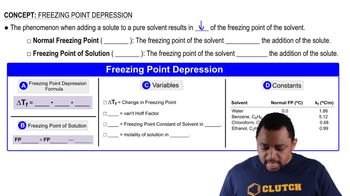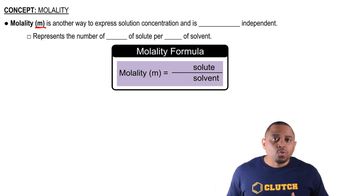Here are the essential concepts you must grasp in order to answer the question correctly.
Freezing Point Depression
Freezing point depression is a colligative property that describes the decrease in the freezing point of a solvent when a solute is added. The extent of this depression depends on the number of solute particles in the solution rather than their identity. This phenomenon can be quantified using the formula ΔTf = Kf * m, where ΔTf is the change in freezing point, Kf is the freezing point depression constant, and m is the molality of the solution.
Recommended video:
Freezing Point Depression
Molality
Molality (m) is a measure of concentration defined as the number of moles of solute per kilogram of solvent. It is particularly useful in colligative property calculations because it directly relates to the number of solute particles in a given mass of solvent. Unlike molarity, which is volume-based, molality remains unaffected by temperature changes, making it ideal for freezing point depression calculations.
Recommended video:
Freezing Point Depression Constant (Kf)
The freezing point depression constant (Kf) is a property specific to each solvent that indicates how much the freezing point of the solvent decreases per mole of solute added per kilogram of solvent. For water, Kf is 1.86 °C·kg/mol, meaning that for every mole of solute dissolved in one kilogram of water, the freezing point will decrease by 1.86 °C. This constant is essential for calculating the new freezing point of solutions.
Recommended video:
Freezing Point Depression
 Verified step by step guidance
Verified step by step guidance

